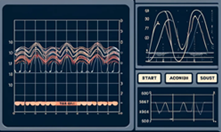近年来,生成式AI(AGI)快速发展,各类生成式模型层出不群,但我更觉得具有物理意义的生成式AI将是未来革命性技术。因此也在抽空看看关于三维重建的知识,这篇文章就是记录我对nerf的理解。
一、论文理解
首先,需要知道nerf的输入和输出是什么?
做cv的朋友都肯定会觉得输入必然是图像,其实图像的输入只是为了后续的loss监督使用,网络的输入是5D向量,包含空间位置xyz和角度theta和phi。
(1)是什么的空间位置xyz和角度theta和phi?
粒子,nerf假设空间中的粒子是自发光的,所以图像的渲染是通过这些自发光粒子得到的。
(2)网络的结构是什么样?

(3)怎样得到这些粒子?
根据像素位置转换到归一化相机坐标系,然后再转换到统一的世界坐标系,沿着射线在2~6的范围内均匀采样64个点作为粒子。世界坐标系的转换矩阵,也就是pose是通过SFM(运动结构恢复)得到的(经典的方法是COLMAP)
(4e)xyz是怎么变为63维的?
通过傅里叶级数将输入的xyz变为高频信号,就像transfomer里面的位置编码一样。这样做的好处是能够区别像素间的差异,对于空间重建比较重要,相邻的两个像素,在空间中的距离也可能距离很大。论文中设的embedding的维度是10,所以10*2*3+3=63。其中2表示sin和cos,3是xyz。
(5)在第5层为什么要加入原始信息?
为了保持更为准确的空间位置。
(6)输出的theta是什么?
在对应的粒子采样点处光线被粒子阻碍的概率密度。
(7)视角的输入维度为什么是3,又怎么变为27?
实际网络的输入是向量,是单位向量表示方向。embedding的维度是4,所以3*2*4+3=27.
(8)为什么视角输入只是在最后加入?
概率密度只和位置相关,颜色和视角相关。
(9)最后怎么样渲染得到图像?
体渲染技术。
(10)nerf的核心是什么?
前处理得到网络输入,后处理体渲染技术,分层采样。
(11)分层采样指的是?
nerf的模型包括corse模型和fine模型,corse模型的采样是(2)中的均匀等距采样,fine模型会根据corse模型输出的weight,采样逆变换采样的方式重新采样得到128个粒子,使得采样更加关注空间中不为空的区域,128+64=192个粒子作为fine模型的输入。
(12)还有其他细节嘛?
为了节省显存,不会整张图对应的射线粒子都会一股脑进入网络,会随机采样1024个像素对应的射线粒子进入网络。
二、代码理解。
获取输入粒子的坐标和方向主要关注以下代码。
def initialize(self):
warange = torch.arange(self.width, dtype=torch.float32, device=self.device)
harange = torch.arange(self.height, dtype=torch.float32, device=self.device)
y, x = torch.meshgrid(harange, warange)
self.transformed_x = (x - self.width * 0.5) / self.focal
self.transformed_y = (y - self.height * 0.5) / self.focal #normailization coord
# pre center crop
self.precrop_index = torch.arange(self.width * self.height).view(self.height, self.width)
dH = int(self.height // 2 * self.precrop_frac)
dW = int(self.width // 2 * self.precrop_frac)
self.precrop_index = self.precrop_index[
self.height // 2 - dH:self.height // 2 + dH,
self.width // 2 - dW:self.width // 2 + dW
].reshape(-1)
poses = torch.FloatTensor(self.poses, device=self.device) #torch.cuda.FloatTensor(self.poses, device=self.device)
all_ray_dirs, all_ray_origins = [], []
for i in range(len(self.images)):
ray_dirs, ray_origins = self.make_rays(self.transformed_x, self.transformed_y, poses[i])
all_ray_dirs.append(ray_dirs)
all_ray_origins.append(ray_origins)
self.all_ray_dirs = torch.stack(all_ray_dirs, dim=0)
self.all_ray_origins = torch.stack(all_ray_origins, dim=0)
self.images = torch.FloatTensor(self.images, device=self.device).view(self.num_image, -1, 3)#torch.cuda.FloatTensor(self.images, device=self.device).view(self.num_image, -1, 3)
def make_rays(self, x, y, pose):
# 100, 100, 3
# 坐标系在-y,-z方向上
directions = torch.stack([x, -y, -torch.ones_like(x)], dim=-1)
camera_matrix = pose[:3, :3]
# 10000 x 3
ray_dirs = directions.reshape(-1, 3) @ camera_matrix.T
ray_origin = pose[:3, 3].view(1, 3).repeat(len(ray_dirs), 1)
return ray_dirs, ray_origin # xyz theta phi体渲染主要关注以下代码。
def predict_to_rgb(sigma, rgb, z_vals, raydirs, white_background=False):
device = sigma.device
delta_prefix = z_vals[..., 1:] - z_vals[..., :-1] #0.0635 sample point delta
delta_addition = torch.full((z_vals.size(0), 1), 1e10, device=device)
delta = torch.cat([delta_prefix, delta_addition], dim=-1)
delta = delta * torch.norm(raydirs[..., None, :], dim=-1)
alpha = 1.0 - torch.exp(-sigma * delta) # 1 - e**-sigma*delta
exp_term = 1.0 - alpha
epsilon = 1e-10
exp_addition = torch.ones(exp_term.size(0), 1, device=device)
exp_term = torch.cat([exp_addition, exp_term + epsilon], dim=-1)
transmittance = torch.cumprod(exp_term, axis=-1)[..., :-1] #(1-alpha0)
weights = alpha * transmittance
rgb = torch.sum(weights[..., None] * rgb, dim=-2)
depth = torch.sum(weights * z_vals, dim=-1)
acc_map = torch.sum(weights, -1)
if white_background:
rgb = rgb + (1.0 - acc_map[..., None])
return rgb, depth, acc_map, weights体渲染的公式:
连续的:

离散的:

不想打字了,去上班挣窝囊费了.....
推荐代码:
shouxieai/nerf: nerf (github.com)
推荐教学视频(讲的真的很好):
【较真系列】讲人话-NeRF全解(原理+代码+公式)_哔哩哔哩_bilibili
推荐b站博主(有时候会去直播,但是看我直播的只有一个人机粉丝):
奈阿伊超



















